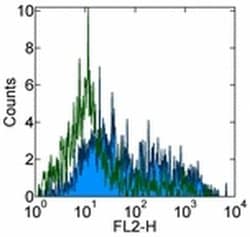Learn More
CD209b (SIGN-R1) Monoclonal Antibody (eBio22D1 (22D1)), Functional Grade, eBioscience™, Invitrogen™ 
Armenian Hamster Monoclonal Antibody
$336.00 - $336.00
Specifications
| Antigen | CD209b (SIGN-R1) |
|---|---|
| Clone | eBio22D1 (22D1) |
| Concentration | 1 mg/mL |
| Applications | ELISA, Flow Cytometry, Functional Assay, Immunohistochemistry (Frozen), Immunoprecipitation |
| Classification | Monoclonal |
Description
The eBio22D1 MAb reacts with mouse SIGNR1 (CD209b). SIGNR1 is a type II transmembrane C-type lectin that was identified in a search for mouse homologues of human DC-SIGN. It is expressed at high levels in splenic marginal zone macrophages and lymph node medullary macrophages, where it functions to uptake dextran polysaccharides, including the capsular polysaccharide of Streptococcus pneumoniae. It has also been demonstrated that SIGNR1 physically associates with TLR4/MD2, and it has been suggested that this association plays a role in recognition of LPS. Furthermore, recently it has been shown that SIGNR1 deficient mice have a defect in catabolism of the complement component C3, and that SIGNR1 binds directly to the complement C1 subcomponent, C1q to assemble a non-conventional C3 convertase. The eBio22D1 MAb does not cross-react with the closely related SIGNR1, SIGNR2, SIGNR3 or SIGNR4.
SIGNR1 is a type II transmembrane C-type lectin that was identified in a search for mouse homologues of human DC-SIGN. It is expressed at high levels in splenic marginal zone macrophages and lymph node medullary macrophages, where it functions to uptake dextran polysaccharides, including the capsular polysaccharide of Streptococcus pneumoniae. It has also been demonstrated that SIGNR1 physically associates with TLR4/MD2, and it has been suggested that this association plays a role in recognition of LPS. Furthermore, recently it has been shown that SIGNR1 deficient mice have a defect in catabolism of the complement component C3, and that SIGNR1 binds directly to the complement C1 subcomponent, C1q to assemble a non-conventional C3 convertase.Specifications
| CD209b (SIGN-R1) | |
| 1 mg/mL | |
| Monoclonal | |
| Liquid | |
| RUO | |
| PBS with no preservative; pH 7.2 | |
| 1810030I22Rik; CD209; CD209 antigen-like protein A; CD209 antigen-like protein B; Cd209a; CD209a antigen; CD209a molecule; Cd209b; CD209b antigen; CDSIGN; CIRE; DC SIGNR1; Dcsign; DC-SIGN; DC-SIGN1; DC-SIGNR1; DC-SIGN-related protein 1; Dendritic cell-specific ICAM-3-grabbing non-integrin; MGC130443; mSIGNR1; OtB7; SIGNR1; SIGN-R1; SIGNR5 | |
| IgG | |
| Affinity Chromatography | |
| Antibody |
| eBio22D1 (22D1) | |
| ELISA, Flow Cytometry, Functional Assay, Immunohistochemistry (Frozen), Immunoprecipitation | |
| Functional Grade | |
| Armenian Hamster | |
| Mouse | |
| Q8CJ91, Q91ZX1 | |
| 170786, 69165 | |
| Primary | |
| 4°C |
